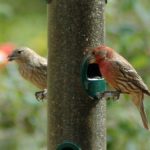House Finch
Carpodacus Mexicanuss
The House Finch (Carpodacus mexicanus) is a medium-sized finch. Adults have a long brown tail and are a brown or dull-brown color across the back with some shading into deep grey on the wing feathers. Breast and belly feathers may be streaked. In most cases, adult males have a reddish color to their heads, necks, and shoulders. This color sometimes extends to the stomach and down the back, between the wings. The male coloration varies in intensity with the seasons and is derived from the berries and fruits in its diet. As a result, the colors range from pale, straw yellow, to bright orange, to deep, intense red. Adult females have brown upperparts and streaked underparts.
These birds are mainly permanent residents; some eastern birds migrate south. Their breeding habitat is urban and semi-open areas from southern Canada to Mexico.
The House Finch forages on the ground or in vegetation. Their diet is mainly seeds and berries, being voracious consumers of weed seeds, such as nettle and dandelion. Consume some insects. They are frequent visitors to feeders throughout the year, particularly if stocked with sunflower seeds or Nyjer/thistle seed. They will congregate at hanging Nyjer sock feeders. Considered a pest in fruit orchards.
Nests are made in cavities, including openings in buildings, and also on various kinds of vegetation, sometimes nests abandoned by other birds will be sued. Nests may be re-used for subsequent broods or in following years. The nest is built by the female, sometimes in as little as two days. It is well made of twigs and debris, forming a cup shape, usually 1.5m to 2m above the ground.
Eggs are laid from February through August, two or more broods per year with 2 to 6 eggs per brood. The eggs are a pale, bluish-green with few black spots and a smooth, somewhat glossy surface. The female incubates the eggs for 12 to 14 days and the young leave the nest about 11 to 19 days after hatching. Dandelion seeds are among the preferred seeds fed to the young.
During courtship, the male may present the female with choice bits of food and, if she imitates the posture of a hungry chick, he may actually feed her. The male may also feed the female during the breeding and incubation period.
Originally a resident of the southwestern United States, during the 1940s, the birds were sold illegally in New York, marketed as the “Hollywood Finch.” Many vendors and owners released the birds into the wild in order to avoid prosecution. The released birds spread rapidly and, in areas that are not forested, have displaced the resident Purple Finch. In 1870, they were introduced into Hawaii.
Their song is a rapid, cheery warble or a variety of chirps. A sample of their song can be heard at the USGS site.
The text within the green border is licensed under the GNU Free Documentation License. To see the full article with more information, visit the Wikipedia article “House Finch“. All content outside the green border is copyrighted by McBryde Website Design.
For more information from the USGS (United States Geological Survey)
on the House Finch, click here.







